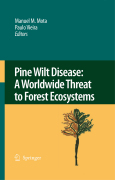
Pine wilt disease: a worldwide threat to forest ecosystems
Vieira, P.R.
Mota, M.M.
The pinewood nematode (PWN), Bursaphelenchus xylophilus, the causal agent of pine wilt disease (PWD), is a serious pest and pathogen of forest tree species, in particular among the genus Pinus. It was first reported from Japan in thebeginning of the XXth century, where it became the major ecological catastrophe of pine forests, with losses reaching over 2 million m3/ year in the 1980s.It has since then spread to other Asian countries such as China, Taiwan and Korea, causing serious losses and economic damage. In 1999, the PWN was first detected in the European Union (EU), in Portugal, and immmediately prompted several government (national and EU) actions to assess the extent of the nematode’s presence, and to contain B. xylophilus and its insect vector (Monochamus galloprovincialis) to an area with a 30 km radius in the Setúbal Peninsula, 20 km south of Lisbon. International wood trade, with its political as well as economic ramifications, has been seriously jeopardized. Highly relevant subject, especialy in Europe, in light of the recent discovery of one of the most dangerous pathogens and pests of pine forests Highly inter-disciplinary text, covering all issues pertaining to pine wilt disease, from molecule to ecosystem, from the nematode to the insect vector, from forest ecology to plant physiology,etc. INDICE: From the contents I: Pine wilt disease: global issues, surveys, trade and economic impact. II: Pine wood nematode: biology and microbial inter-relationships. III: PWN taxonomy and detection methods. IV: The insect vectors:biology, ecology and interaction with PWN. V: Ecology and modelling. VI: The tree: physiology, resistance and histopathology as a result of pine wilt disease. VII: PWN and insect vector control methods.
- ISBN: 978-1-4020-8454-6
- Editorial: Springer
- Encuadernacion: Cartoné
- Páginas: 300
- Fecha Publicación: 01/06/2008
- Nº Volúmenes: 1
- Idioma: Inglés
